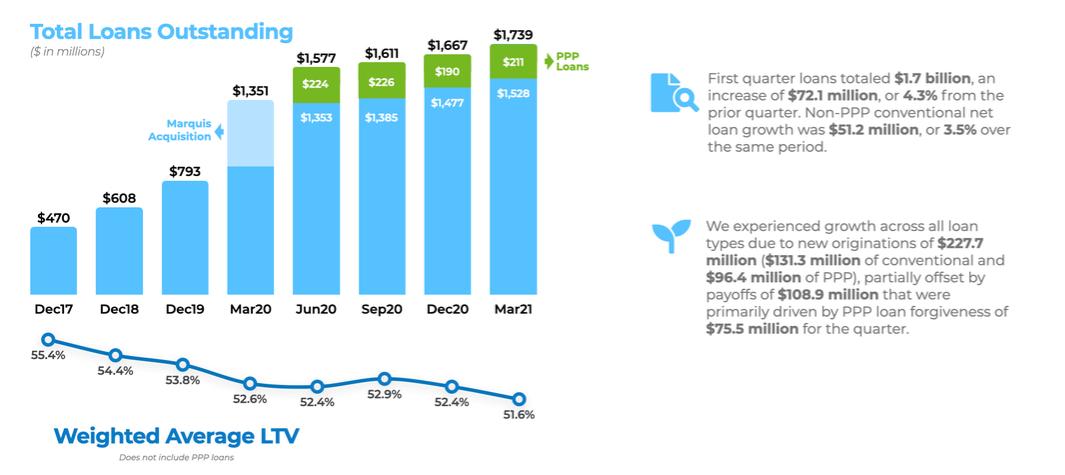At March 31, 2021, there were six impaired loans (consisting of nonaccrual loans, troubled debt restructured loans, loans past due 90 days or more and still accruing interest and other loans based on management’s judgment) with both unpaid principal balance and recorded investments totaling $5.4 million. Three of these were impaired loans with a recorded investment of $2.8 million with an allowance of $0.7 million and one substandard accruing loan with a recorded investment of $2.3 million with no allowance. The average net investment on the impaired residential real estate and commercial loans during the three months ended March 31, 2021 were $0.9 million. Residential real estate loans had $2.6 thousand and $3.7 thousand interest income recognized for the three months ended March 31, 2021, and 2020, respectively, which was equal to the cash basis interest income. At December 31, 2020, there were six impaired loans with recorded investments totaling $13.1 million, of which there were three impaired loans with a recorded investment of $10.4 million on nonaccrual with an allowance of $8.3 million and one substandard accruing loan with a recorded investment of $2.4 million with no allowance. The average net investment on the impaired residential real estate and commercial loans during the year ended December 31, 2020, was $2.2 million. The residential real estate loans had $12.7 thousand of interest income recognized during the year ended December 31, 2020, which was equal to the cash basis interest income.
Troubled Debt Restructurings:
The principal carrying balances of loans that met the criteria for consideration as troubled debt restructurings (“TDR”) were $272 thousand and $298 thousand as of March 31, 2021, and December 31, 2020, respectively. The Company has allocated no specific reserves to customers whose loan terms have been modified in troubled debt restructurings as of March 31, 2021, and December 31, 2020. The Company has not committed any additional amounts to customers whose loans are classified as a troubled debt restructuring.
Credit Quality Indicators:
The Company categorizes loans into risk categories based on relevant information about the ability of borrowers to service their debt including: current financial information, historical payment experience, credit documentation, public information, and current economic trends, among other factors. Generally, all credits greater than $1.0 million are reviewed at least annually to monitor and adjust, if necessary, the credit risk profile. Loans classified as substandard or special mention are reviewed quarterly by the Company for further evaluation to determine if they are appropriately classified and whether there is any impairment. Beyond the annual review, all loans are graded upon initial issuance. In addition, during the renewal process of any loan, as well as if a loan becomes past due, the Company will determine the appropriate loan grade.
Loans excluded from the review process above are generally classified as pass credits until: (a) they become past due; (b) management becomes aware of deterioration in the creditworthiness of the borrower; or (c) the customer contacts the Company for a modification. In these circumstances, the loan is specifically evaluated for potential classification as to special mention, substandard, doubtful, or even charged-off. The Company uses the following definitions for risk ratings:
Pass: A Pass loan’s primary source of loan repayment is satisfactory, with secondary sources very likely to be realized if necessary. The pass category includes the following:
Riskless: Loans that are fully secured by liquid, properly margined collateral (listed stock, bonds, or other securities; savings accounts; certificates of deposit; loans or that portion thereof which are guaranteed by the U.S. Government or agencies backed by the “full faith and credit” thereof; loans secured by properly executed letters of credit from prime financial institutions).
High Quality Risk: Loans to recognized national companies and well-seasoned companies that enjoy ready access to major capital markets or to a range of financing alternatives. Borrower’s public debt offerings are accorded highest ratings by recognized rating agencies, e.g., Moody’s or Standard & Poor’s. Companies display sound financial conditions and consistent superior income performance. The borrower’s trends and those of the industry to which it belongs are positive.
Satisfactory Risk: Loans to borrowers, reasonably well established, that display satisfactory financial conditions, operating results and excellent future potential. Capacity to service debt is amply demonstrated. Current financial strength, while financially adequate, may be deficient in a number of respects. Normal comfort levels are achieved through a closely monitored collateral position and/or the strength of outside guarantors.
Moderate Risk: Loans to borrowers who are in non-compliance with periodic reporting requirements of the loan agreement, and any other credit file documentation deficiencies, which do not otherwise affect the borrower’s credit risk profile. This may include borrowers who fail to supply updated financial information that supports the adequacy of the primary source of repayment to service the Bank’s debt and prevents bank management to evaluate the borrower’s current debt service capacity. Existing loans will include those with consistent


